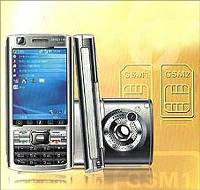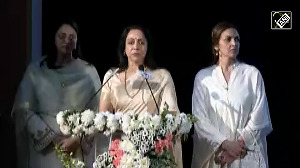Just when you thought dual-SIM handsets would suffice, manufacturers are planning to offer triple and even multi-SIM handsets.
 Deepak Shikar had two connections from different mobile service providers. He used one handset for official work and the other for personal use. But that was till last month, when his friend told him about dual-SIM handsets. Now, Shikar simply switches calls with a flick of a button.
Deepak Shikar had two connections from different mobile service providers. He used one handset for official work and the other for personal use. But that was till last month, when his friend told him about dual-SIM handsets. Now, Shikar simply switches calls with a flick of a button.
Sales of dual-SIM phones are growing at more than 100 per cent, say analysts. From a marginal 3 per cent share of the overall market last year, dual-SIM phones now account for nearly 15 per cent, according to the latest data from ORG-GfK, a marketing and services solutions company. While the dual-SIM market was, till recently, dominated by Chinese vendors and imports, leading brands like Samsung, Nokia, Spice and LG are now planning to make inroads. New brands are also entering this segment with not just dual-SIM but also triple-SIM and multi-SIM handsets.
Intex Technologies, for instance, launched its first triple-SIM handset, priced at Rs 4,700. Karbonn Mobiles, too, announced triple-SIM handsets (two GSM and one CDMA), priced at Rs 5,200.
Intex Technologies' triple-SIM handset can take two GSM cards and a CDMA SIM, and offers connectivity over three different networks. Sudhir Kumar, national sales manager - telecom, Intex Technologies, said, "Even smaller towns and cities are gearing up for dual - and triple - SIM handsets because they are very practical."
For the financial year-end March 2010, Intex Technologies is expecting a turnover of Rs 650 crore. While nationally it has a share of 1.5 per cent for a market that sells 10-12 million handsets per month, it is targeting a share of 5 per cent by September 2011.
Spice Mobile Chief Executive Officer Kunal Ahooja, told Business Standard, "We already offer dual-SIM handsets. We are evaluating the possibility of offering triple-SIM handsets. Many new operators have brought down tariffs and consumers now tend to carry more than one connection to avail of the best deals."
Around 90 per cent of handsets sold by Spice are dual-SIM. Ahooja estimates that dual-SIM handsets could easily account for close to 50 per cent of the total Indian mobile phone market in the next two-three years.
Karbonn Mobiles, which is the official mobile phone partner for the Indian Premier League this year, has also launched a triple-SIM handset. Karbonn Mobiles is a joint venture between Jaina Group (a mobile phone and consumer durables distributor based in Delhi) and UTL Group - Bangalore-based telecom company. Pradeep Jain, managing director, Jaina Group, said that the company has already sold 3 million devices in India since its launch in March 2009.
The Indian Cellular Association President Pankaj Mohindroo feels multi-SIM handsets will continue to boom till number portability comes into play across all the telecom circles. "Once number portability is introduced, dual or multi-SIM handset sales may drop because a lot of existing users of dual-SIM use it for maintaining more than one phone number," says Mohindroo.
"There are not too many triple-SIM handset options in India currently, but it is an emerging market. Around 10-12 million handsets are sold per month in India, of which dual-SIM handsets would account for around 2 million," he adds.
Manufacturers like Samsung and LG, meanwhile, are focusing on the dual-SIM handset market. A spokesperson for Samsung Mobiles says, "By December 2010, we expect dual-SIM handsets to make up for 20 per cent of our total handsets sold." Samsung dual-SIM handsets are priced between Rs 4,600 and Rs 11,600. Samsung, at present, has three dual-sim phone models and has plans to introduce such handsets with touch-screen capabilities. The company's dual-SIM handsets boast of capabilities whereby both the SIMs are active simultaneously.
Nokia is also planning to roll out dual-SIM phones in India this year. A Nokia India spokesperson said that although dual-SIM phones are a niche segment, both urban and rural India are gearing up for it.
The benefits of using a multi-SIM handset cannot be overlooked. Consumers can check the difference in signal strengths of different service providers and choose the operator that has a better signal strength to a make call. This is more useful when using a GSM and a CDMA service for a dual-SIM handset.
Telecom sector analysts are also of the opinion that as India Inc expands, it is important to ensure that its contact points spread over the country can reach an individual without making STD calls and paying roaming charges.
However, analysts also highlight a few limitations of multi-SIM handsets. For instance, when the dual-SIM phone battery goes out, both the connections are lost. Also, the dual-SIM capability raises the phone price by Rs 900 to Rs 1,800. Moreover, a few of the dual-SIM phones available in the market at a cheap price are not really dual-SIM phones. They have two SIM card slots but only one of the SIMs can be activated at a time.











